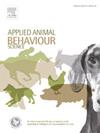Monitoring night-time activity and perch occupation of laying hens using night-vision cameras for the early detection of poultry red mite: A proof of concept
IF 2.2
2区 农林科学
Q1 AGRICULTURE, DAIRY & ANIMAL SCIENCE
引用次数: 0
Abstract
Poultry red mite (PRM) infestations impact hen welfare and behaviour. Current PRM monitoring, relying on mite trapping or scoring tools, can underestimate PRM infestation levels, hindering farm-specific guidance regarding PRM control. Therefore, this study aimed to identify early indicators of PRM infestation by automatically monitoring changes in hen night-time activity and perch occupation. To achieve this, night-vision cameras recorded hen behaviour on the aviary’s top tier. An event detection algorithm was developed to quantify the percentage of non-moving hens and the number of birds occupying specific perches in each video. Simultaneously, PRM was monitored using cardboard traps, and silica treatment (ST) was applied to significantly reduce mite numbers when needed. Before monitoring period 1 (MP1; weeks 1 – 42), preventive measures were taken to minimize PRM infestation upon birds’ arrival. PRM were first detected in traps in week 19, increased until ST1 in weeks 29 – 30, dropped significantly post-ST1, but reached their maximum by the end of MP1. Before monitoring period 2 (MP2; weeks 50 – 70), ST2 was applied in weeks 48 – 49 to ensure a lower PRM infestation level. The Spearman’s rank correlation showed a strong negative association between the weekly averaged percentage of non-moving hens and mean PRM count for MP1 (-0.84, p < 0.0001), while a weaker relationship was found for MP2 (-0.27, p = 0.2407). This study demonstrates the potential of automated behavioural monitoring for early PRM detection and farm-specific guidance within dynamic Integrated Pest Management (IPM) strategies. Strong correlations between the percentage of non-moving hens and PRM counts in MP1 highlighted the ability to detect infestations earlier than traditional methods. Changes in perch occupation in MP1 further supported infestation progression and suggested treatment efficacy thereafter. However, weaker trends in MP2 emphasize the importance of preventive measures against PRM and the potential influence of external factors on behaviour.
求助全文
约1分钟内获得全文
求助全文
来源期刊

Applied Animal Behaviour Science
农林科学-行为科学
CiteScore
4.40
自引率
21.70%
发文量
191
审稿时长
18.1 weeks
期刊介绍:
This journal publishes relevant information on the behaviour of domesticated and utilized animals.
Topics covered include:
-Behaviour of farm, zoo and laboratory animals in relation to animal management and welfare
-Behaviour of companion animals in relation to behavioural problems, for example, in relation to the training of dogs for different purposes, in relation to behavioural problems
-Studies of the behaviour of wild animals when these studies are relevant from an applied perspective, for example in relation to wildlife management, pest management or nature conservation
-Methodological studies within relevant fields
The principal subjects are farm, companion and laboratory animals, including, of course, poultry. The journal also deals with the following animal subjects:
-Those involved in any farming system, e.g. deer, rabbits and fur-bearing animals
-Those in ANY form of confinement, e.g. zoos, safari parks and other forms of display
-Feral animals, and any animal species which impinge on farming operations, e.g. as causes of loss or damage
-Species used for hunting, recreation etc. may also be considered as acceptable subjects in some instances
-Laboratory animals, if the material relates to their behavioural requirements
 求助内容:
求助内容: 应助结果提醒方式:
应助结果提醒方式:


